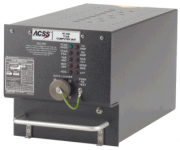RT-950
RT-950 is a model designation of TCAS computer (heart of TCAS 2000 system) developed by Honeywell and later all design data and production was transferred to ACSS (Aviation Communication & Surveillance Systems).
Original Manufacturer: Aviation Communication & Surveillance Systems (USA)
Status: in production (since 1997)
Application: multiple
ATA 100/JACS Code: 34-45
HTS Code: 8526 91 0010, 8526 91 8010, 9801 10 0000 (for repairs or alterations - see Chapter 98)
► Click here to download official OEM's datasheet.
Contents
Part Numbers
| Unit P/N | Notes |
|---|---|
| 7517900-10yyy [1] | |
| 7517900-10001 | Change 6.04a (TSO-C119a) |
| 7517900-10002 | Change 6.04a (TSO-C119a) |
| 7517900-10003 | Change 7.0 (TSO-C119b) |
| 7517900-10004 | Change 7.0 (TSO-C119b) |
| 7517900-10006 | Change 7.0 (TSO-C119b) |
| 7517900-10007 | Change 7.0 (TSO-C119b) |
| 7517900-10010 | Change 7.0 (TSO-C119b) |
| 7517900-10011 | Change 7.0 (TSO-C119b) |
| 7517900-10012 | SB (fixed Interference Limiting) |
| 7517900-10020 | Change 7.1 (TSO-C119c) |
1. The last three digits of the five digit dash number (yyy) correspond to the unit software version.
Features
The purpose of the TCAS (Traffic Alert and Collision Avoidance System) is to determine the range, altitude, and bearing of other aircraft equipped with Mode S/Air Traffic Control Radar Beacon System (ATCRBS) transponders, with respect to the location of own aircraft. It also monitors the trajectory of these aircraft for the purpose of determining if any of them constitute a potential collision hazard. The TCAS is responsible for estimating the projected intruder track and determining if a potential conflict exists. If so, the system displays an advisory to the pilot. The system also provides guidance for the optimum vertical avoidance maneuver. Complementary avoidance maneuvers between two TCAS equipped aircraft are ensured by coordination of mutual intentions with the other aircraft through the Mode S transponders.
The TCAS 2000 is an onboard advisory system designed to act as a backup to the air traffic control (ATC) radar and the ìsee and avoidî procedures. By computing the closure rate and altitude of all transponder equipped aircraft in the surrounding airspace, the TCAS can anticipate a potential midair collision before it has a chance to materialize. TCAS 2000 continually plots local air traffic on the associated display, and in the event of a conflicting flightpath, guides the pilot towards the correct avoidance maneuver. If the intruding aircraft is also equipped with a TCAS II compatible system, the two systems can communicate their mutual intentions through the Mode S transponders. The coordinated advisories that result allow the two pilots to execute complementary avoidance maneuvers.
System Interfaces:
- Radio Altimeter Interface (either analog or digital radio altimeter inputs)
- Mode S Transponder Interface
- Onboard Maintenance System Interface
- Data Loader Interface
- TCAS Display Bus interface
- Performance Management Bus Interface
- Magnetic Heading/Attitude Bus Interface
- RS-422 Flight Data Recorder Interface
- ARINC 573 Flight Data Recorder Interface
- ARINC 429 Flight Data Recorder Interface
- Voice Audio Outputs
- RS-232 Interface (for connection to a PC)
- Altitude Alerter Interface (ARINC 429 low speed input bus)
- Reserved ARINC 429 Bus Interface
Specifications
Electrical:
Operating Voltage:
- DC Voltage: +20.5 Vdc min, +27.5 Vdc nominal, +32.2 Vdc max
- AC Voltage: 97 Vrms min, 115 Vrms nominal, 134 Vrms max at 400 ± 80 Hz
Power Consumption: 55 Watts standby, 65 Watts nominal, 85 Watts max
Transmitter Frequency: 1030 ± 0.01 MHz
RF Peak Output Power:
- Minimum: 53.3 dBm (210 Watts)
- Nominal: 55.3 dBm (335 Watts)
- Maximum: 57.3 dBm (540 Watts)
Receiver Frequency Range: 1087 to 1093 MHz
Mechanical:
- Mounting: 6 MCU (ARINC 600) Tray Assembly
- Height: 7.66 in (194.6 mm)
- Width: 7.52 in (191.0 mm)
- Length: 15.26 in (387.6 mm)
- Weight: 15.78 lb (7.16 kg)
Environmental:
- Environmental Compliance: DO-160C [A2F2]YBB[CLMY][E1]XXXXXZ[EBZ]A[EZ]ZRZA3E3XX
- Operating Temperature: -55 to +70 degrees C
- Ground Survival Temperature: -55 to +85 degrees C
- Altitude: Sea Level to 55,000 feet
Approval
- Part No. 7517900-xx001 and –xx002: TSO C119a
- Part No. 7517900-xx003 thru –xx012: TSO C119b, ETSO C119b
- Part No. 7517900-10020 and above: TSO C119c, ETSO C119c
- Software Development Specification: DO-178B, Level B
- Environmental Specifications: DO-160C
Installation
- P/N A09-3841-001 TCAS 2000 Traffic Alert and Collision Avoidance System Description and Installation Manual
Operation
- P/N 8006773-001 TCAS 2000/3000 Traffic Collision Avoidance System Pilot's Guide
- P/N 8008110-001 TCAS II/2000 (Change 7.1) Pilot's Guide Supplement
Maintenance
Detailed instructions for repair and adjustment of RT-950 TCAS Computer Unit are presented in the component maintenance manual P/N A09-3841-002 (ATA 34-43-11).
